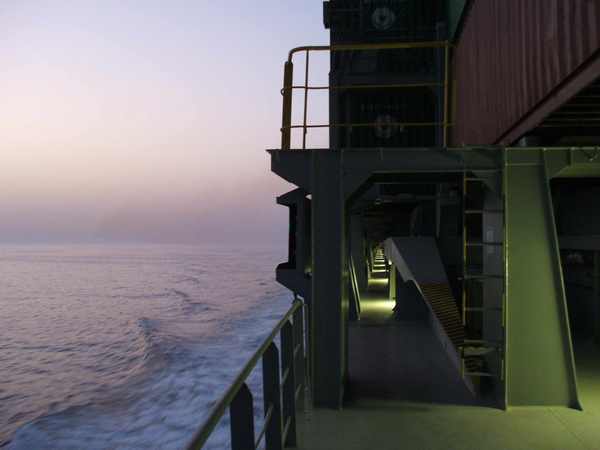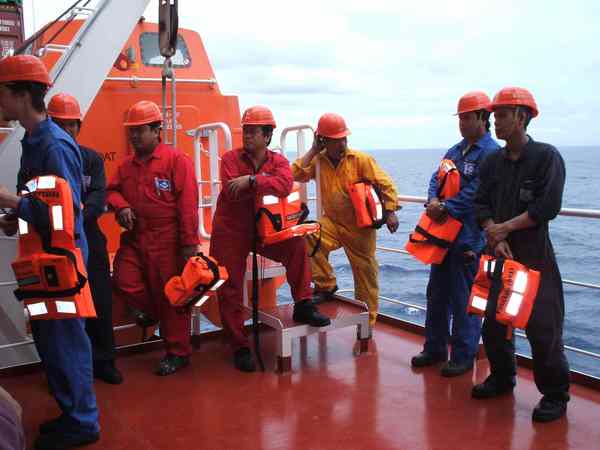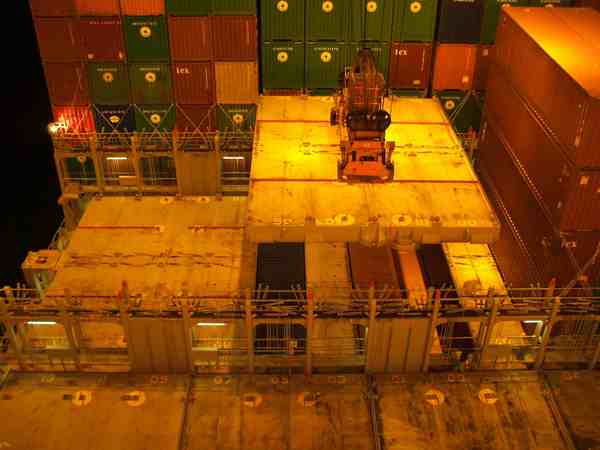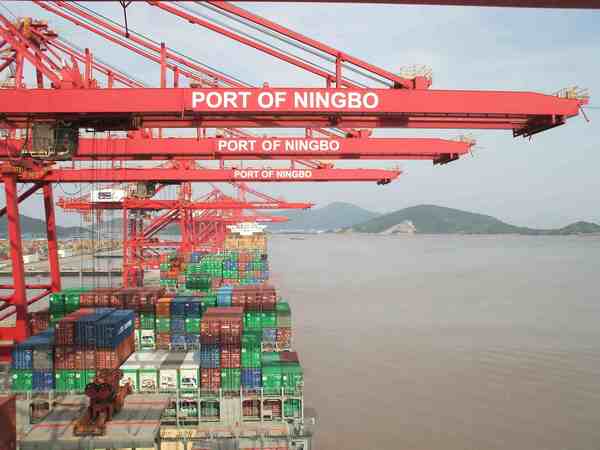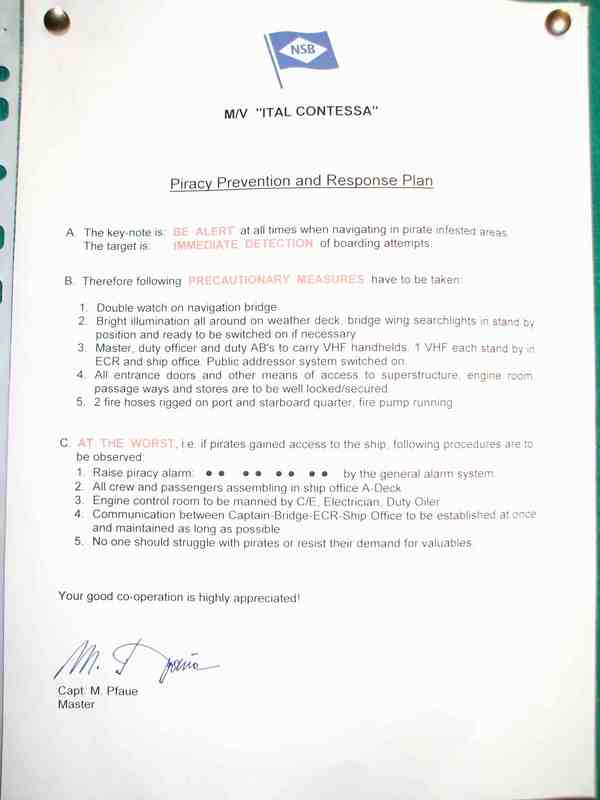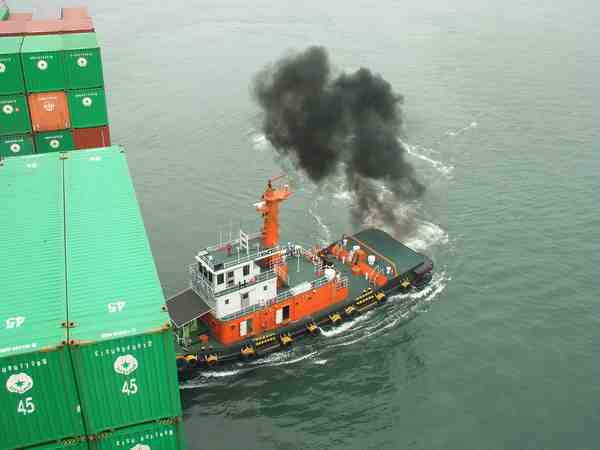April 22, 2009
Transnational limbo
A couple of fascinating responses to the container post (in addition to Owen's remarks, of course - speaking of whom, to complete the circuit described in this post: would you believe that I've actually been working on a post on Pakula's Parallax View) for the past week or so?)
First up on the containers, Frieze's Dan Fox(who also took the photos which illustrate this post):
I travelled on a container ship from Thamesport, via Suez, to Shanghai this time last year (roughly when the Somalian pirates decided it was time to get busy in the Gulf of Aden). It was a pretty mindblowing trip. The whole area around Thamesport - the Isle of Grain - is particularly spooky. I'm sure, living in Kent, you've explored that area. As you get closer, the landscape empties out and flattens. The roads are quite narrow country roads, but full of big lorries pelting along to and from the port. As you get closer, the first thing you see is a huge power station at the edge of the port, and then, in the distance, the cranes come into view. I have to confess I arrived at the port at about 7AM feeling pretty nervous, so I was maybe a little too preoccupied to take it all in, however, the landscape reminded me of the area around Dungeness - a mixture of small villages, which don't seem to have any buildings older than the 1930s at the earliest (though I'm possibly wrong about that), wildlife reserves and military establishments.
- Thamesport is, of course, a high security zone - there are thorough passport and ID checks at the gates, and I wasn't allowed to proceed any further until the captain of the ship I was travelling on had confirmed I was expected. You're driven everywhere in container ports - there's no idle wandering about - but this is principally a safety measure. There are lorries and trucks belting along, stacked with with containers, and the cranes shift these heavy containers at an alarming speed. Deaths from falling containers or from being run-over are not unusual.
- The experience of docking in port, and watching the sheer speed at which containers are unloaded and loaded is quite something - it's fast and dangerous. Money is everything - the stevedores' cranes start lifting containers literally the minute the ship has moored and tied its ropes to the quayside, and the ship leaves the moment they stop. Fuel costs are minimized at any given opportunity - three types of fuel are used, at three different degrees of filthiness. The cheapest, and dirtiest one, is used in open sea. You can see the sheen from fuel discharges on the water's surface everywhere on shipping routes. If there is a snag with the docking schedules - a delay, or a ship arriving too early, then often the ship's captain will declare that the ship is 'not under command', which isn't quite as dramatic as it sounds, and involves the engines being switched off and the ship drifting for a few hours in order to regulate its schedule. (It's quite something to be drifting on a giant, but silent, container ship in the middle of the ocean at night, as happened to me in the East China Sea.)
- Most industrial ports these days are situated far outside the cities they purport to be located in (for instance, Shanghai's deep water container port is Yangshan - which is situated on an island 30km off the coast, and about an hour or so drive from Shanghai itself - it's connected to the mainland by the Donghai Bridge, third longest bridge in the world) and ships are only docked for about 15-20 hours at most, which means that the merchant seamen rarely get enough shore leave time to escape the port terminals. As such they live in a kind of transnational limbo (6-7 months at a time is the usual length of a shift - I think it's a bit less for the officer class), never really officially arriving in any country unless they have a rare long stop over or have errands to run outside the ports. The crew on the ship I travelled on were all Filipino, and the officers German. I only saw crew members go ashore once on my trip, in Kaohsiung, Taiwan, which is situated, unusually, just a very short cab ride from the city centre.
- It was fascinating to see how the two ports I saw in China compared to Thamesport. I stopped at Ningbo (allegedly, according to the sailors on the ship I was on, a Triad controlled port), and Shanghai/Yangshan, and this time last year at least, I got the impression that China was a country in a hurry. That may well have changed, and I wonder how they seem this year. The thing that really hits home, travelling by container ship, is just how - and this might seem like an obvious thing to say - bound we are to the physicality and materiality of trade. The media allows to believe that we are all somehow living in a wireless, broadband, endlessly twittering, blogging world of instantaneous, at-the-touch-of-a-button, smiling, cute-electronica-soundtracked communication and trade, yet seeing hundreds of these vast container ships shifting boxes from one place to another, many filled with the hardware that allows us to twitter and blog our lives away, is quite something. (The ship I was on was over 300 metres long. One day I timed myself walking, point-to-point all the way around, which is the kind of thing you begin to get worryingly into doing after 3 weeks at sea without setting foot on shore, and at a good, steady pace, it took me 10 minutes to walk its entire circumference.) The lumpen materiality of our systems takes on a renewed significance. The Somalian pirates have identified this - the need to physically transport things means that by controlling the narrow bottleneck that is the Gulf of Aden, you can potentially choke east-west trade. Without the Suez route, trade with South East Asia is in massive jeopardy - or at least will become increasingly expensive as shipping insurance goes up, or as shipping companies choose to reroute their vessels far lengthier distances (I'm by no means an expert, but I'd say this is unlikely, as I got the impression from the crew I met that shipping companies care about the bottom line more than the safety of their crews).
Next up The Wire (magazine's) Derek Walmsley:
- I see that people have pointed out to you that Series Two of The Wire
is based in a dock. The scale of it was awesome (they actually filmed
in a working dock), completely dwarfing any human presence. Worth checking the titles:
- Whereas if you watch any dock footage of London from the 30s and 40s,
one gets more or less the opposite impression... you're astonished to see the banks of the river are often just that, river banks, no massive cranes or concrete bays.... worth checking those out if you're at the BFI mediatheque at any point, they have films of London from that era.
Douglas Murphy adds:
-
I suppose this is a bit late (missing the boat, perhaps?), but when I was doing my MA we read this book, a sort of post-Deleuzo-Koolhaasian examination of various 'free zones' across the world, places where immaterial capital is forced to become material, such as the tip of southern Spain where all the Moroccans legally/illegally work in tomato farms, the Indian techno-districts, the North Korean holiday resort for South Koreans, etc etc. I must say that it's not brilliant, it has quite a generic architecture-theory style, but there is a pretty interesting chapter on containerisation and the container ports themselves, discussing the rapidly diminishing labour forces resulting from automation (far in excess of what you see in The Wire), the legal frameworks and special freedoms given to these spaces. It might be worth a look if you were going further into the subject, I suppose.
